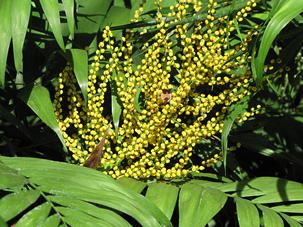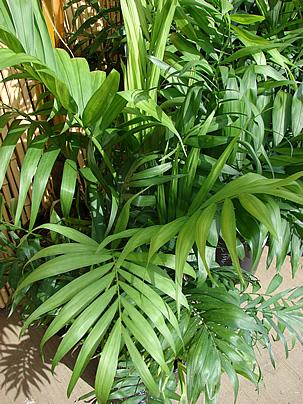Parlour Palm (Chamaedorea elegans) is a small-sized, dioecious, and thorn-free palm native to Mexico and Guatemala. It has gained immense popularity as an ornamental plant, particularly indoors, due to its tropical appeal and easy cultivation. Despite appearances, this palm has a single stem (trunk) and is commonly planted in groups of three or more individuals.
The stem is cylindrical, slender, and marked by scars from fallen leaves. The leaves are pinnate, shiny, and densely arranged at the top of the plant. The inflorescence appears in spring and summer and is a type of raceme, with tiny yellow flowers of little ornamental significance. The fruits are berry-like, small, black, and spherical.

This charming palm can be used in well-lit and not overly dry interior decor. It is commonly found in offices, malls, living rooms, etc. With moderate growth, low maintenance, and invariably adding a tropical touch to environments, it is often cultivated in dense groups, tabletop or corner arrangements, and is very common in mini gardens and terrariums.
The Parlour Palm can also be grown individually in garden beds, patios, or balconies, planted in pots or directly in the ground, but always protected from direct sunlight. Ideal for small gardens or areas that require a smaller scale due to its size.
It should be grown in partial shade or diffuse light, in a substrate rich in organic matter, well-draining, and irrigated frequently. Direct sunlight will cause leaf burns. It appreciates heat and ambient humidity, so it’s advisable to avoid areas with drafts or air conditioning, although it can survive for quite some time in these conditions.
In temperate climates, it is advisable to protect the plant from cold temperatures indoors during the fall and winter months. The substrate for Parlour Palm should be kept moist, without drying out completely between waterings. Yellowed or dry-tipped leaves indicate a lack of humidity. On cloudy or rainy days, we can take the opportunity to hose down the plant in the yard to remove any dust that may have accumulated on the leaves.
Fertilize monthly during the warmer months, using fertilizers suitable for palms. Despite its resistance to extensive root binding, it is advisable to transplant Parlour Palm to a larger pot every two or three years. It propagates through seeds, depulped and freshly harvested, placed to germinate in a mixture of sand and potting soil, kept moist.


